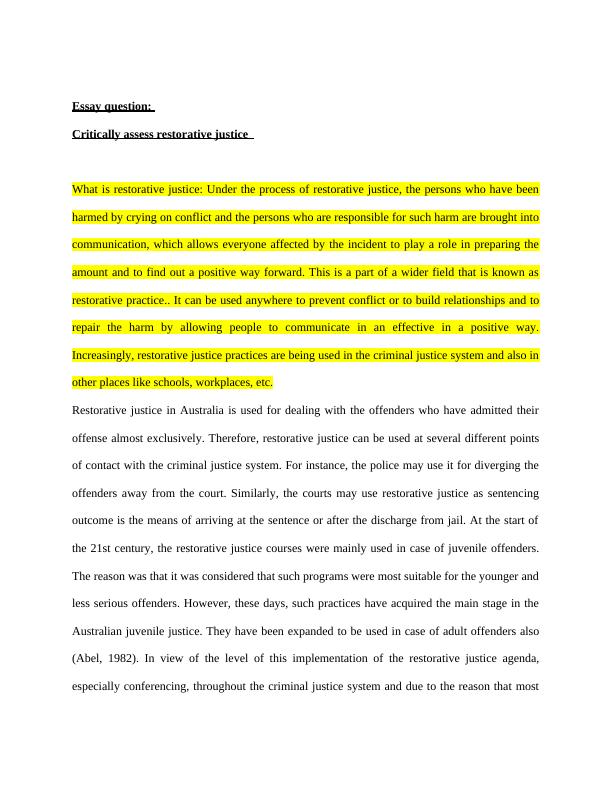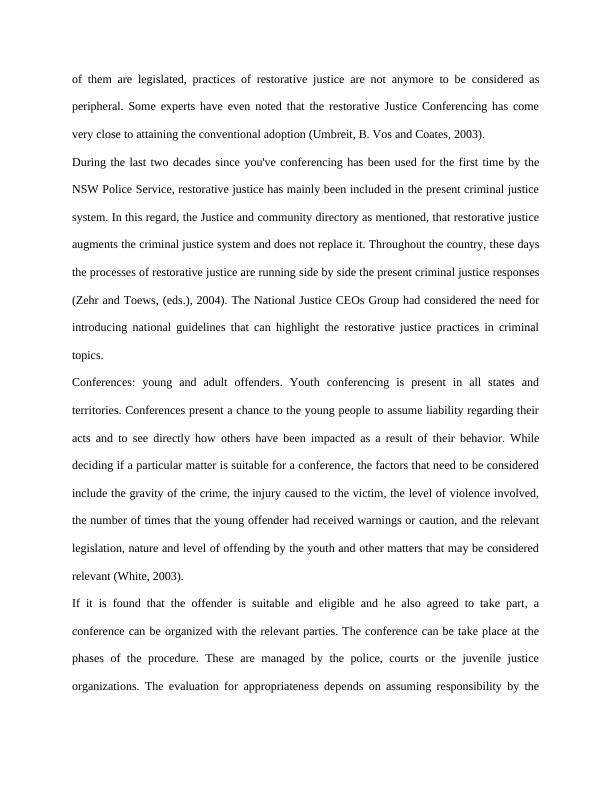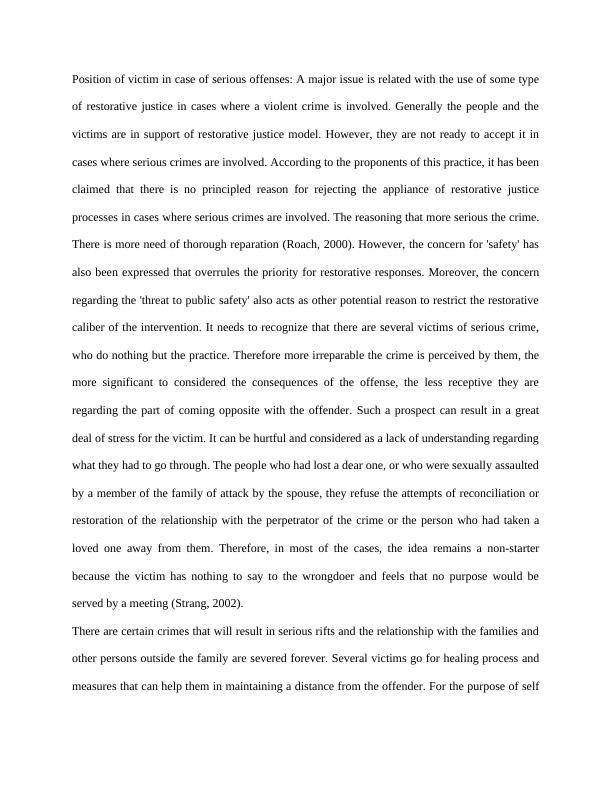Critically Assessing Restorative Justice
13 Pages4272 Words346 Views
Added on 2023-06-12
About This Document
This essay critically assesses the concept of restorative justice, its implementation in the criminal justice system, and its impact on victims. It discusses the use of restorative justice in dealing with offenders, the position of victims in cases of serious offenses, power imbalances, and risks to the rights of victims. The essay also explores the concept of good and bad victims and the challenges faced by victims in the criminal justice system.
Critically Assessing Restorative Justice
Added on 2023-06-12
ShareRelated Documents
Essay question:
Critically assess restorative justice
What is restorative justice: Under the process of restorative justice, the persons who have been
harmed by crying on conflict and the persons who are responsible for such harm are brought into
communication, which allows everyone affected by the incident to play a role in preparing the
amount and to find out a positive way forward. This is a part of a wider field that is known as
restorative practice.. It can be used anywhere to prevent conflict or to build relationships and to
repair the harm by allowing people to communicate in an effective in a positive way.
Increasingly, restorative justice practices are being used in the criminal justice system and also in
other places like schools, workplaces, etc.
Restorative justice in Australia is used for dealing with the offenders who have admitted their
offense almost exclusively. Therefore, restorative justice can be used at several different points
of contact with the criminal justice system. For instance, the police may use it for diverging the
offenders away from the court. Similarly, the courts may use restorative justice as sentencing
outcome is the means of arriving at the sentence or after the discharge from jail. At the start of
the 21st century, the restorative justice courses were mainly used in case of juvenile offenders.
The reason was that it was considered that such programs were most suitable for the younger and
less serious offenders. However, these days, such practices have acquired the main stage in the
Australian juvenile justice. They have been expanded to be used in case of adult offenders also
(Abel, 1982). In view of the level of this implementation of the restorative justice agenda,
especially conferencing, throughout the criminal justice system and due to the reason that most
Critically assess restorative justice
What is restorative justice: Under the process of restorative justice, the persons who have been
harmed by crying on conflict and the persons who are responsible for such harm are brought into
communication, which allows everyone affected by the incident to play a role in preparing the
amount and to find out a positive way forward. This is a part of a wider field that is known as
restorative practice.. It can be used anywhere to prevent conflict or to build relationships and to
repair the harm by allowing people to communicate in an effective in a positive way.
Increasingly, restorative justice practices are being used in the criminal justice system and also in
other places like schools, workplaces, etc.
Restorative justice in Australia is used for dealing with the offenders who have admitted their
offense almost exclusively. Therefore, restorative justice can be used at several different points
of contact with the criminal justice system. For instance, the police may use it for diverging the
offenders away from the court. Similarly, the courts may use restorative justice as sentencing
outcome is the means of arriving at the sentence or after the discharge from jail. At the start of
the 21st century, the restorative justice courses were mainly used in case of juvenile offenders.
The reason was that it was considered that such programs were most suitable for the younger and
less serious offenders. However, these days, such practices have acquired the main stage in the
Australian juvenile justice. They have been expanded to be used in case of adult offenders also
(Abel, 1982). In view of the level of this implementation of the restorative justice agenda,
especially conferencing, throughout the criminal justice system and due to the reason that most

of them are legislated, practices of restorative justice are not anymore to be considered as
peripheral. Some experts have even noted that the restorative Justice Conferencing has come
very close to attaining the conventional adoption (Umbreit, B. Vos and Coates, 2003).
During the last two decades since you've conferencing has been used for the first time by the
NSW Police Service, restorative justice has mainly been included in the present criminal justice
system. In this regard, the Justice and community directory as mentioned, that restorative justice
augments the criminal justice system and does not replace it. Throughout the country, these days
the processes of restorative justice are running side by side the present criminal justice responses
(Zehr and Toews, (eds.), 2004). The National Justice CEOs Group had considered the need for
introducing national guidelines that can highlight the restorative justice practices in criminal
topics.
Conferences: young and adult offenders. Youth conferencing is present in all states and
territories. Conferences present a chance to the young people to assume liability regarding their
acts and to see directly how others have been impacted as a result of their behavior. While
deciding if a particular matter is suitable for a conference, the factors that need to be considered
include the gravity of the crime, the injury caused to the victim, the level of violence involved,
the number of times that the young offender had received warnings or caution, and the relevant
legislation, nature and level of offending by the youth and other matters that may be considered
relevant (White, 2003).
If it is found that the offender is suitable and eligible and he also agreed to take part, a
conference can be organized with the relevant parties. The conference can be take place at the
phases of the procedure. These are managed by the police, courts or the juvenile justice
organizations. The evaluation for appropriateness depends on assuming responsibility by the
peripheral. Some experts have even noted that the restorative Justice Conferencing has come
very close to attaining the conventional adoption (Umbreit, B. Vos and Coates, 2003).
During the last two decades since you've conferencing has been used for the first time by the
NSW Police Service, restorative justice has mainly been included in the present criminal justice
system. In this regard, the Justice and community directory as mentioned, that restorative justice
augments the criminal justice system and does not replace it. Throughout the country, these days
the processes of restorative justice are running side by side the present criminal justice responses
(Zehr and Toews, (eds.), 2004). The National Justice CEOs Group had considered the need for
introducing national guidelines that can highlight the restorative justice practices in criminal
topics.
Conferences: young and adult offenders. Youth conferencing is present in all states and
territories. Conferences present a chance to the young people to assume liability regarding their
acts and to see directly how others have been impacted as a result of their behavior. While
deciding if a particular matter is suitable for a conference, the factors that need to be considered
include the gravity of the crime, the injury caused to the victim, the level of violence involved,
the number of times that the young offender had received warnings or caution, and the relevant
legislation, nature and level of offending by the youth and other matters that may be considered
relevant (White, 2003).
If it is found that the offender is suitable and eligible and he also agreed to take part, a
conference can be organized with the relevant parties. The conference can be take place at the
phases of the procedure. These are managed by the police, courts or the juvenile justice
organizations. The evaluation for appropriateness depends on assuming responsibility by the

wrongdoer, the level of remorse and the feelings towards the victim (Walller, 1989). The
interpersonal skills and different other safety matters including cultural values and substance
abuse are also considered. Generally, this involves bringing victim and the offender face to face
in the presence of facilitators, police and other support persons who try to mend the damage
created due to the actions of the offender and find out an intervention plan or agree regarding an
undertaking for the offender. There are certain jurisdictions where conferences can take place
without the presence of the victim (Stubbs, 2002). The plan includes an apology or reparation to
the victim, donating to charity, doing community service or working for the victim or their
parents. Similarly conferencing can also include drugs or alcohol treatment in cases where it has
been identified as resulting in an influence on the offending behavior. Usually the agreed
outcome should not be more onerous than what would be ordered by the court (Marshall and
Merry, 1990). On the other hand, if an offender does not comply with the outcomes of a
conference, the offender can return to conventional criminal justice system. However in certain
jurisdictions, some discretion is available regarding the way matters involving offender who has
not complied with the agreement, have to be dealt with, along with a warning or no further
action.
Restorative justice from the viewpoint of injured party: it is acknowledged that a gap is present
among the aspirations of restorative justice and the actual practices. The presence of such gap
should not be surprising for us as the principles for restorative justice have been positioned very
high, probably too high. Most astonishing claims have been made by the advocates of restorative
justice regarding what we can attain and what it can do for the victims or their families and the
community. Consequently a gap emerges partly as a result of the inflated expectations regarding
what can be achieved by restorative justice (Braithwaite, 2002).
interpersonal skills and different other safety matters including cultural values and substance
abuse are also considered. Generally, this involves bringing victim and the offender face to face
in the presence of facilitators, police and other support persons who try to mend the damage
created due to the actions of the offender and find out an intervention plan or agree regarding an
undertaking for the offender. There are certain jurisdictions where conferences can take place
without the presence of the victim (Stubbs, 2002). The plan includes an apology or reparation to
the victim, donating to charity, doing community service or working for the victim or their
parents. Similarly conferencing can also include drugs or alcohol treatment in cases where it has
been identified as resulting in an influence on the offending behavior. Usually the agreed
outcome should not be more onerous than what would be ordered by the court (Marshall and
Merry, 1990). On the other hand, if an offender does not comply with the outcomes of a
conference, the offender can return to conventional criminal justice system. However in certain
jurisdictions, some discretion is available regarding the way matters involving offender who has
not complied with the agreement, have to be dealt with, along with a warning or no further
action.
Restorative justice from the viewpoint of injured party: it is acknowledged that a gap is present
among the aspirations of restorative justice and the actual practices. The presence of such gap
should not be surprising for us as the principles for restorative justice have been positioned very
high, probably too high. Most astonishing claims have been made by the advocates of restorative
justice regarding what we can attain and what it can do for the victims or their families and the
community. Consequently a gap emerges partly as a result of the inflated expectations regarding
what can be achieved by restorative justice (Braithwaite, 2002).

Position of victim in case of serious offenses: A major issue is related with the use of some type
of restorative justice in cases where a violent crime is involved. Generally the people and the
victims are in support of restorative justice model. However, they are not ready to accept it in
cases where serious crimes are involved. According to the proponents of this practice, it has been
claimed that there is no principled reason for rejecting the appliance of restorative justice
processes in cases where serious crimes are involved. The reasoning that more serious the crime.
There is more need of thorough reparation (Roach, 2000). However, the concern for 'safety' has
also been expressed that overrules the priority for restorative responses. Moreover, the concern
regarding the 'threat to public safety' also acts as other potential reason to restrict the restorative
caliber of the intervention. It needs to recognize that there are several victims of serious crime,
who do nothing but the practice. Therefore more irreparable the crime is perceived by them, the
more significant to considered the consequences of the offense, the less receptive they are
regarding the part of coming opposite with the offender. Such a prospect can result in a great
deal of stress for the victim. It can be hurtful and considered as a lack of understanding regarding
what they had to go through. The people who had lost a dear one, or who were sexually assaulted
by a member of the family of attack by the spouse, they refuse the attempts of reconciliation or
restoration of the relationship with the perpetrator of the crime or the person who had taken a
loved one away from them. Therefore, in most of the cases, the idea remains a non-starter
because the victim has nothing to say to the wrongdoer and feels that no purpose would be
served by a meeting (Strang, 2002).
There are certain crimes that will result in serious rifts and the relationship with the families and
other persons outside the family are severed forever. Several victims go for healing process and
measures that can help them in maintaining a distance from the offender. For the purpose of self
of restorative justice in cases where a violent crime is involved. Generally the people and the
victims are in support of restorative justice model. However, they are not ready to accept it in
cases where serious crimes are involved. According to the proponents of this practice, it has been
claimed that there is no principled reason for rejecting the appliance of restorative justice
processes in cases where serious crimes are involved. The reasoning that more serious the crime.
There is more need of thorough reparation (Roach, 2000). However, the concern for 'safety' has
also been expressed that overrules the priority for restorative responses. Moreover, the concern
regarding the 'threat to public safety' also acts as other potential reason to restrict the restorative
caliber of the intervention. It needs to recognize that there are several victims of serious crime,
who do nothing but the practice. Therefore more irreparable the crime is perceived by them, the
more significant to considered the consequences of the offense, the less receptive they are
regarding the part of coming opposite with the offender. Such a prospect can result in a great
deal of stress for the victim. It can be hurtful and considered as a lack of understanding regarding
what they had to go through. The people who had lost a dear one, or who were sexually assaulted
by a member of the family of attack by the spouse, they refuse the attempts of reconciliation or
restoration of the relationship with the perpetrator of the crime or the person who had taken a
loved one away from them. Therefore, in most of the cases, the idea remains a non-starter
because the victim has nothing to say to the wrongdoer and feels that no purpose would be
served by a meeting (Strang, 2002).
There are certain crimes that will result in serious rifts and the relationship with the families and
other persons outside the family are severed forever. Several victims go for healing process and
measures that can help them in maintaining a distance from the offender. For the purpose of self

End of preview
Want to access all the pages? Upload your documents or become a member.
Related Documents
Restorative Criminal Justice System: Key Issues and Impactslg...
|4
|944
|366
Crime Causation and Diversionlg...
|12
|810
|19
Restorative Justice for Young Female Offenders: A Critical Evaluationlg...
|15
|1834
|280
Restorative Justicelg...
|10
|2972
|261
Proposed Amendment of Young Offenders Act, 1997 (NSW) for Youth Justice Conferencing in Sexual Offenseslg...
|7
|2012
|74
Restorative Justice Programs in Victoria and New South Waleslg...
|6
|1618
|67
